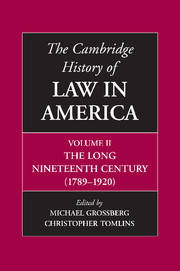Book contents
- Frontmatter
- 1 Law and the American State, from the Revolution to the Civil War: Institutional Growth and Structural Change
- 2 Legal Education and Legal Thought, 1790–1920
- 3 The Legal Profession: From the Revolution to the Civil War
- 4 The Courts, 1790–1920
- 5 Criminal Justice in the United States, 1790–1920: A Government of Laws or Men?
- 6 Citizenship And Immigration Law, 1800–1924: Resolutions Of Membership And Territory
- 7 Federal Policy, Western Movement, and Consequences for Indigenous People, 1790–1920
- 8 Marriage and Domestic Relations
- 9 Slavery, Anti-Slavery, and the Coming of the Civil War
- 10 The Civil War And Reconstruction
- 11 Law, Personhood, and Citizenship in the Long Nineteenth Century: the Borders of Belonging
- 12 Law in Popular Culture, 1790–1920: The People and the Law
- 13 Law and Religion, 1790–1920
- 14 Legal Innovation and Market Capitalism, 1790–1920
- 15 Innovations in Law and Technology, 1790–1920
- 16 The Laws of Industrial Organization, 1870–1920
- 17 The Military in American Legal History
- 18 The United States and International Affairs, 1789–1919
- 19 Politics, State-Building, and the Courts, 1870–1920
- Bibliographic Essays
- Notes on Contributors
- Index
- References
12 - Law in Popular Culture, 1790–1920: The People and the Law
Published online by Cambridge University Press: 28 November 2008
- Frontmatter
- 1 Law and the American State, from the Revolution to the Civil War: Institutional Growth and Structural Change
- 2 Legal Education and Legal Thought, 1790–1920
- 3 The Legal Profession: From the Revolution to the Civil War
- 4 The Courts, 1790–1920
- 5 Criminal Justice in the United States, 1790–1920: A Government of Laws or Men?
- 6 Citizenship And Immigration Law, 1800–1924: Resolutions Of Membership And Territory
- 7 Federal Policy, Western Movement, and Consequences for Indigenous People, 1790–1920
- 8 Marriage and Domestic Relations
- 9 Slavery, Anti-Slavery, and the Coming of the Civil War
- 10 The Civil War And Reconstruction
- 11 Law, Personhood, and Citizenship in the Long Nineteenth Century: the Borders of Belonging
- 12 Law in Popular Culture, 1790–1920: The People and the Law
- 13 Law and Religion, 1790–1920
- 14 Legal Innovation and Market Capitalism, 1790–1920
- 15 Innovations in Law and Technology, 1790–1920
- 16 The Laws of Industrial Organization, 1870–1920
- 17 The Military in American Legal History
- 18 The United States and International Affairs, 1789–1919
- 19 Politics, State-Building, and the Courts, 1870–1920
- Bibliographic Essays
- Notes on Contributors
- Index
- References
Summary
Law has been a source of popular interest for centuries. From tabloid journalism to serious news coverage to everything in between, legal conflicts and controversies have been capturing the public’s imagination ever since the nation’s inception and, arguably, before. With the advent of movies, radio, and television in the twentieth century, popular representations of law have become commonplace, but even before these technologies were invented, the law had considerable popular appeal. Unable to appreciate the spectacle of courtroom justice via satellite from their homes, people in the nineteenth century satisfied their curiosity about recent legal developments by attending trials in person and by keeping up with the flood of newspaper and magazine articles devoted to legal events. Helping fuel an unquenchable demand for law-related stories, book publishers like Beadle and Adams churned out thousands of dime novels whose plots revolved around crimes, while artists and craftsmen made their own contributions in the form of public statues, coins, paintings, and medallions devoted to legal themes. Virtually no area of life was unaffected by the popular obsession with the law. During the infamous trial of the preacher Henry Ward Beecher for adultery in 1875, for example, the law even found its way into a popular playground rhyme that “testified” to the preacher’s integrity: “Beecher, Beecher is my name – Beecher till I die! I never kissed Mis’ Tilton – I never told a lie!”
- Type
- Chapter
- Information
- The Cambridge History of Law in America , pp. 387 - 416Publisher: Cambridge University PressPrint publication year: 2008

